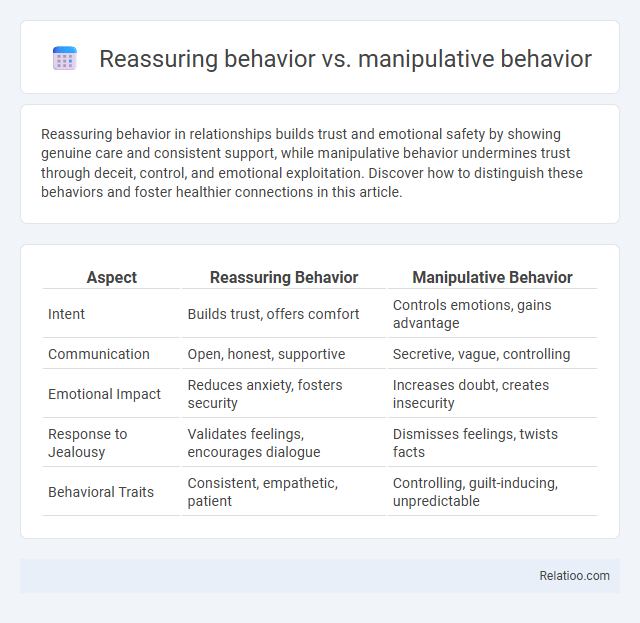Reassuring behavior in relationships builds trust and emotional safety by showing genuine care and consistent support, while manipulative behavior undermines trust through deceit, control, and emotional exploitation. Discover how to distinguish these behaviors and foster healthier connections in this article.
Table of Comparison
| Aspect | Reassuring Behavior | Manipulative Behavior |
|---|---|---|
| Intent | Builds trust, offers comfort | Controls emotions, gains advantage |
| Communication | Open, honest, supportive | Secretive, vague, controlling |
| Emotional Impact | Reduces anxiety, fosters security | Increases doubt, creates insecurity |
| Response to Jealousy | Validates feelings, encourages dialogue | Dismisses feelings, twists facts |
| Behavioral Traits | Consistent, empathetic, patient | Controlling, guilt-inducing, unpredictable |
Understanding Reassuring Behavior
Understanding reassuring behavior involves recognizing actions that offer comfort, support, and affirmation without controlling or influencing others for personal gain. Reassuring behavior fosters trust and emotional safety by being empathetic, transparent, and sincere, unlike manipulative behavior which uses deceit or guilt to achieve hidden motives. Distinguishing genuine reassurance from manipulation helps improve communication and strengthens healthy relationships.
Defining Manipulative Behavior
Manipulative behavior involves controlling or influencing others in a deceptive or exploitative way to serve personal interests, often undermining trust and genuine communication. Reassuring behavior, in contrast, promotes a sense of safety and confidence by providing honest support and understanding without hidden motives. Your ability to recognize manipulators helps you maintain healthy boundaries and foster authentic relationships built on respect.
Key Differences Between Reassurance and Manipulation
Reassuring behavior involves providing honest support and comfort, fostering trust and emotional security, while manipulative behavior exploits others' vulnerabilities to control or influence outcomes for personal gain. Key differences lie in intent and transparency: reassurance aims to alleviate fear without hidden motives, whereas manipulation relies on deceit and emotional distortion. Recognizing these distinctions helps identify genuine empathy versus exploitative tactics in interpersonal relationships.
Psychological Roots of Reassurance
Reassuring behavior stems from a genuine psychological need to provide comfort and alleviate anxiety, often rooted in empathy and secure attachment patterns. Manipulative behavior, in contrast, arises from underlying insecurities or a desire for control, using reassurance as a tool to influence others for personal gain rather than mutual support. Understanding these psychological roots highlights the difference between authentic reassurance that fosters trust and manipulative tactics that undermine emotional safety.
Motivations Behind Manipulation
Manipulative behavior is driven by self-interest, control, and the desire to influence others for personal gain, often at the expense of genuine emotional connection. In contrast, reassuring behavior aims to provide comfort and support, motivated by empathy and the intention to strengthen trust in relationships. Understanding these motivations highlights how manipulation erodes trust, whereas reassurance fosters healthy communication and mutual respect.
Common Signs of Reassuring Interactions
Reassuring behavior often includes active listening, empathetic responses, and consistent nonverbal cues such as nodding and maintaining eye contact, which foster trust and comfort in your interactions. Unlike manipulative behavior characterized by deceit, guilt-tripping, or inconsistency, reassuring interactions provide clear, honest communication and emotional support. Recognizing these signs helps you distinguish genuine reassurance from manipulation, ensuring healthier, more authentic relationships.
Warning Signals of Manipulative Actions
Warning signals of manipulative behavior include inconsistencies in communication, excessive flattery followed by demands, and attempts to control your decisions through guilt or pressure. Reassuring behavior, in contrast, respects your boundaries, offers transparency, and supports your autonomy without coercion. Recognizing these differences helps you protect yourself from emotional exploitation and maintain healthy relationships.
Impact on Relationships: Reassurance vs Manipulation
Reassuring behavior fosters trust and emotional security, strengthening relationships through consistent support and empathy. Manipulative behavior erodes trust by exploiting vulnerabilities, leading to confusion, resentment, and emotional distance. The clear distinction lies in reassurance promoting healthy connection, while manipulation undermines genuine intimacy and mutual respect.
How to Respond to Manipulative Behavior
Recognizing manipulative behavior is essential for protecting your emotional well-being; it often involves guilt-tripping, gaslighting, or intentionally misleading actions to control your decisions. Your best response includes setting clear boundaries, maintaining firm communication, and avoiding over-explaining or justifying your choices to prevent being drawn into the manipulator's tactics. Reassuring behavior, in contrast, encourages open, honest dialogue and empathy, fostering trust without coercion or control.
Building Healthy, Trust-Based Communication
Reassuring behavior fosters healthy, trust-based communication through genuine empathy, active listening, and consistent support, creating a safe emotional environment essential for relationship growth. Manipulative behavior undermines trust by exploiting vulnerabilities, using deceit, and controlling tactics that distort genuine interactions and breed insecurity. Prioritizing sincere reassurance over manipulation cultivates open dialogue, mutual respect, and emotional safety, which are foundational for sustainable, healthy connections.

Infographic: Reassuring behavior vs Manipulative behavior
 relatioo.com
relatioo.com